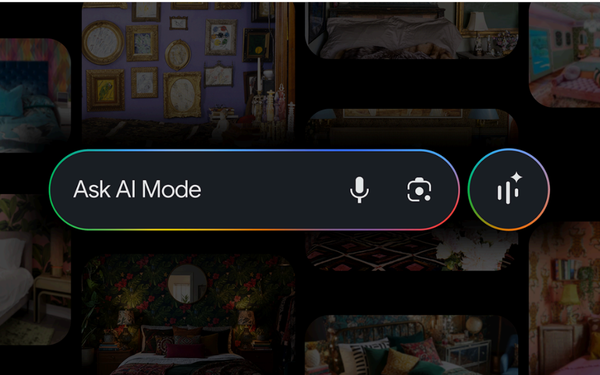
Google introduced a major update to AI Mode in Google Search on
Tuesday that moved its advertising and marketing into an inspirational and more visual era of search.
The update makes it easier to ask longer and more natural questions to explore visual
content.
While Google hopes visual search will increase the desire for consumers to click through to a brand's websites, it also moves search into the next stage of agentic shopping when
AI agents will find and purchase products from across the web on their behalf.
Through a type of visual inspiration, consumers now can ask questions and in return, see a range of visual
results in AI Mode.
The experience is multimodal, which means the content becomes available in audio, video, text and more.
Users can start a search by uploading an image or
taking a photo, and see a visual response with links to explore different types of content across the web. This allows consumers to go back and forth between AI Mode and Google Search.
advertisement
advertisement
The feature is powered by Google's visual search fan-out technique, a core part of AI Mode. The technique requires an AI system to break down a complex image query into multiple
related sub-queries.
It then gathers information from various sources from across the web about the visual content, according to Google. The fan-out technique will not differentiate between
real and AI-generated visuals, but the technology looks for general signals based on relevance of the query.
The technology relies on Google’s understanding of the image through the
eyes of Gemini 2.5’s advanced multimodal capabilities and combines it with Google Search. It analyzes an image's subtle details and runs multiple background queries to grasp the full context of
the question and deliver the most relevant results.
If a consumer queries “I’m looking for barrel jeans that are not too baggy,” the technology will suggest the consumer look
for styles “with a slimmer and more tapered fit.” The term “not too baggy” is subjective, so it also may provide more detail as to why it offered this type of advice.
AI Mode enables consumers to shop conversationally by describing exactly what the consumer needs, similar to the way one friend may talk with another. The shopping experience uses Google Shopping
Graph, which consists of more than 50 billion product listings.
For example, if someone searches for a type of inspiration around maximalist design for a bedroom, AI Mode will help to clarify
vague ideas that could set the person searching in a new direction. AI Mode will turn it into a specific vision.
The AI will look across the Shopping Graph to get a better understanding of
what the query means. The model reasons about what to return based on descriptions and reviews.
The platform is much more intuitive and visual. It will return ideas and allow the person
searching to ask additional questions for more options such as lighter or darker tones and bold prints. Each image has a link, so the shopper can click through to learn more when something catches
their attention.
Over time the technology also will learn preferences, even if they change, and serve up more of those brands.